You won’t be surprised to learn that 61.4% of the world’s population uses social media today, will you? No wonder social media platforms serve as powerful tools for increasing brand awareness. However, creating an effective social media marketing strategy requires careful planning and execution.
This blog post will guide you through the critical steps to crafting a winning social media marketing strategy pdf that delivers measurable results. We’ll cover setting clear goals, understanding your target audience, conducting competitive analysis, and choosing the right platforms.
So, if you’re ready to unlock the full potential of your social media presence, let’s get started!
Setting Clear Goals
Setting clear goals is crucial in developing a successful social media marketing strategy presentation.
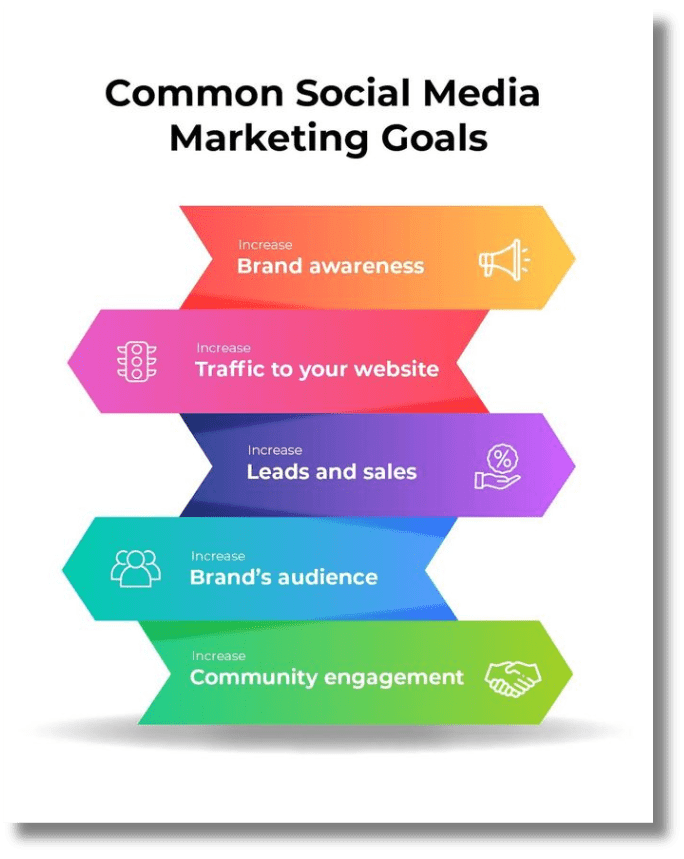
For instance, if your primary business objective is to increase sales, your social media goals should focus on driving conversions and generating leads.
Similarly, here are some more examples of social media goals you may want to conside in your social media marketing strategy:
- Increasing Followers: Aim to increase your follower count by 20% over the next three months. This goal is specific, measurable, achievable, relevant, and time-bound.
- Improving Brand Awareness: Prioritize creating content that enhances visibility and engages potential customers.
- Boosting Engagement Rates: Set a goal to increase engagement rates on your posts by 15% within the next quarter. This goal focuses on improving interaction with your audience, which is vital for building community and loyalty.
- Driving Traffic to the Website: Establish a goal to drive 500 additional visitors to your website from social media platforms each month. This goal directly ties social media efforts to your business’s objective of increasing website traffic and potential conversions.
Setting clear goals for your social media marketing strategy lays the foundation for success. It also helps you measure progress and adjust your tactics as needed.
Understanding Your Target Audience
Knowing your audience is another aspect of creating a successful social media marketing strategy. This way, you can craft relevant content that resonates with them and drives engagement.
For example, the social media marketing strategy for real estate will be entirely different than one for a bakery.
Here is what you can do to understand your audience better:
Audience Research
Without proper audience research, your social media efforts may miss the mark, resulting in wasted resources and diminished returns. When you understand your audience’s values, you can tailor your messaging to address their pain points and aspirations.

This relevance increases the likelihood of engagement, shares, and conversions. Additionally, knowing your audience allows you to choose the right social media platforms to reach them effectively.
Demographic Analysis
Analyzing demographics is a vital step in defining your target audience. Demographics include age, gender, location, income level, education, and occupation. To conduct demographic analysis, you can use various tools and methods:
Social Media Insights
Most social media platforms provide analytics tools that offer valuable demographic information about your followers. For example, Facebook Insights and Instagram Analytics can show you the age range, gender distribution, and geographic locations of your audience.
Surveys and Polls
Conducting surveys or polls can provide direct insights into your audience’s demographics and preferences. You can use tools like Google Forms or ask auestions in your Facebook and Instagram to gather this information.
Market Research Reports
Utilize existing social media marketing strategy research relevant to your industry. Such reports often contain valuable demographic data and trends that can inform your audience analysis. This way, you can better gauge who your audience is and how to engage them effectively.
Creating Audience Personas
Creating detailed audience personas is an effective way to tailor your content and messaging. An audience persona is a semi-fictional representation of your ideal customer based on real data and insights.
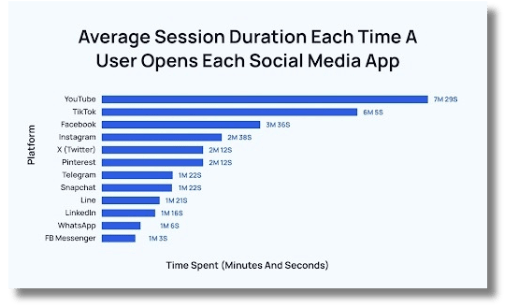
Here’s how to create effective audience personas and them to your social media marketing strategy ppt:
Gather Data
Use the demographic analysis and audience research you’ve conducted to gather data points. Look for common characteristics among your audience, such as age, interests, and behaviors.
Identify Pain Points and Goals
Understand your audience’s challenges and what they hope to achieve. This insight will help you create content that addresses their needs.
Develop Persona Profiles
Create profiles for each persona, including a name, age, job title, interests, and a brief description of their goals and challenges. For example, you might have a persona named “Marketing Mary,” a 30-year-old marketing manager interested in social media trends and looking for ways to improve her brand’s online presence.
Tailor Content and Messaging
Use these personas to guide your content creation and messaging strategies. Consider what type of content will resonate with each persona and how you can address their specific needs and interests. This ensures that your content is relevant and engaging, ultimately driving better results for your business.
Conducting Competitive Analysis
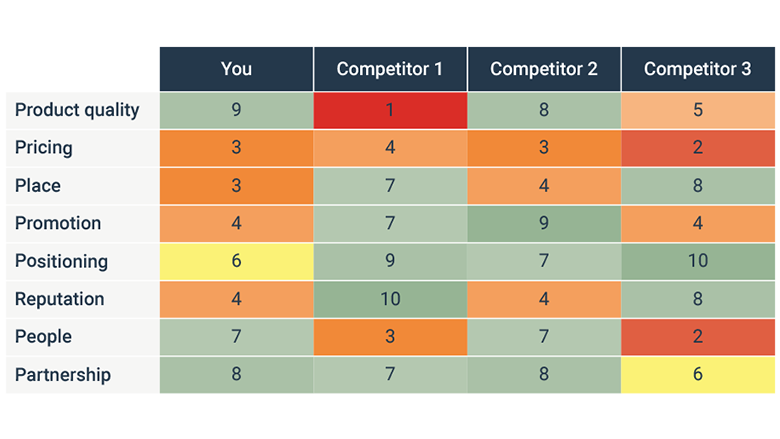
Conducting a competitive analysis enables you to identify opportunities, refine your approach, and differentiate your brand in the marketplace.
The first step in competitive analysis is identifying key competitors in your industry. Start by defining your market niche and your specific products or services.
Once you have a clear understanding of your position, you can identify competitors through various methods:
Online Searches
Conduct searches on Google and social media platforms to find businesses that offer similar products or services. Look for companies that appear frequently in search results or have a strong social media presence.
Social Media Platforms
Use social media to identify competitors by exploring industry-related hashtags and following relevant conversations. Pay attention to brands that engage with your target audience.
Customer Feedback
Gather insights from your customers about which brands they consider alternatives to your offerings. This feedback can provide valuable information about who your competitors are.
Industry Reports
Review industry reports and market research studies highlighting key players in your field. These documents often provide a comprehensive overview of the competitive landscape. You may also find a social media marketing example to benchmark this way.
By identifying your competitors, you can analyze their strategies and understand their positioning in the market.
Analyzing Competitor Strategies
Once you have identified your competitors, the next step is to analyze their social media presence. This will help you come up with a better marketing strategy.
Here are some key takeaways to consider:
Content Types
Review the types of content your competitors post on their social media channels. Look for trends in content formats, such as images, videos, infographics, or blog links. Assess their themes and topics to understand what resonates with their audience.
Identify Best Practices
Look for successful tactics that your competitors use to engage their audience. This could include specific content types, posting schedules, or engagement techniques. Adopting best practices can help improve your social media strategy.
Spot Gaps and Opportunities
Identify areas where competitors may be lacking. For example, if they focus heavily on one platform but neglect others, you might find an opportunity to fill that gap and reach an untapped audience.
Avoid Pitfalls
Learn from competitors’ mistakes by observing what doesn’t work for them. If certain types of content receive low engagement or negative feedback, avoid making similar errors in your strategy.
You can gain valuable insights that inform your social media marketing strategy by conducting a thorough competitive analysis. This understanding enables you to position your brand effectively, differentiate your offerings, and ultimately achieve better results in your social media efforts.
Choosing the Right Social Media Platforms
With numerous options available, choosing platforms that align with your target audience and business objectives is important. As a business owner, you need to ensure that your target audience is hanging out on the platforms you are choosing.
Besides, you will also need to roll out tailored strategies to make the most of each respective social media platform.
Overview of Popular Platforms
Once you have selected the social media channels to market your business, the next step is to plan out your strategy. Download your social media marketing strategy template free and get going.
But first, let’s quickly overview the popular platforms businesses are scaling on:
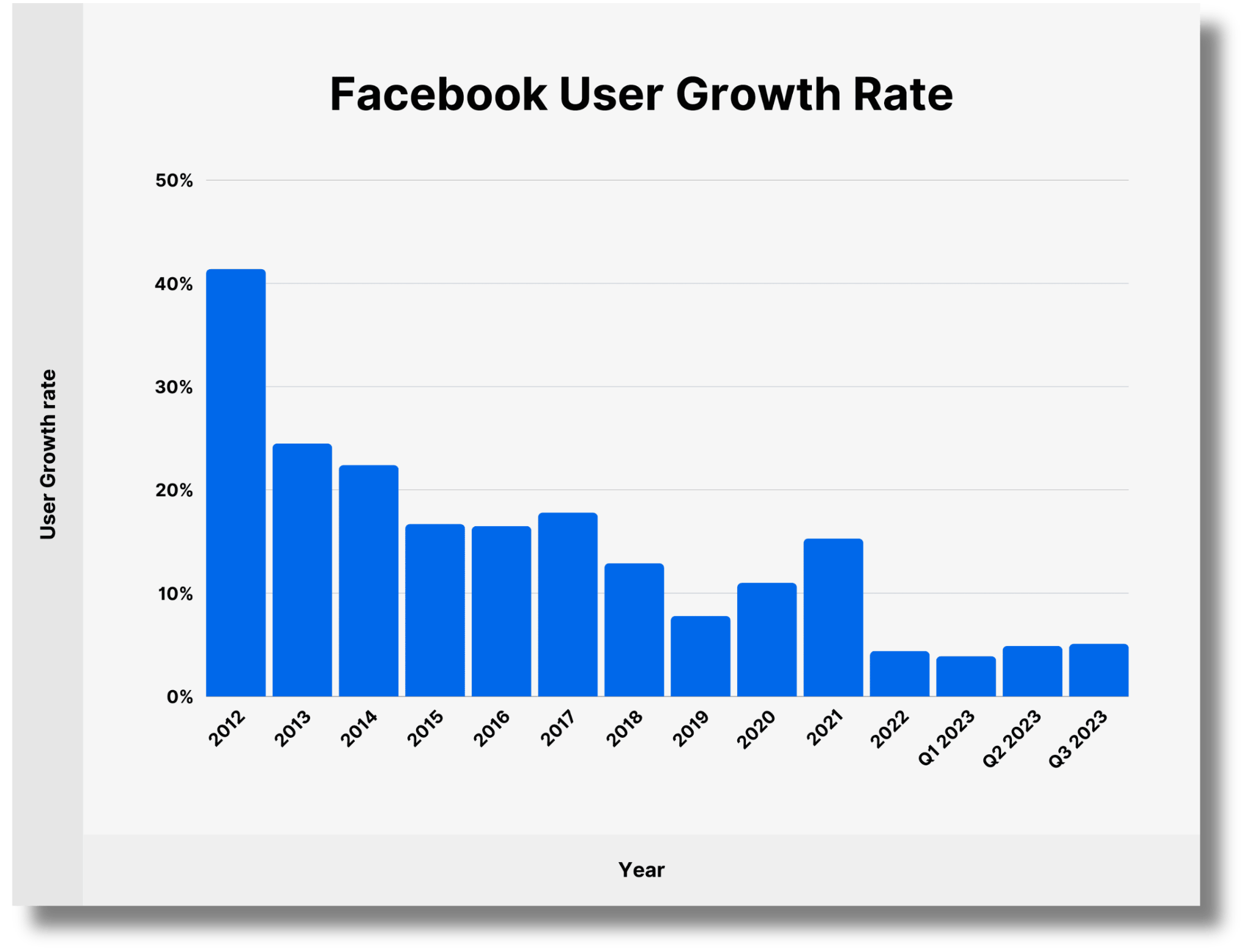
With over 2.9 billion monthly active users, Facebook is the largest social media platform. It caters to a broad audience and is suitable for various types of content, from text-based posts to images and videos.
Facebook is particularly effective for building brand awareness and fostering customers relationships.

Instagram is a visually-driven platform that excels in showcasing products and services. With over 1 billion monthly active users, Instagram is popular among younger demographics, making it an attractive choice for businesses targeting millennials and Gen Z.

Twitter is known for its real-time updates and conversations. It’s an excellent platform for building brand awareness, engaging with customers, and participating in industry discussions.
Twitter’s hashtag feature allows users to discover and join relevant conversations.

LinkedIn is the leading professional social network, with over 800 million members in more than 200 countries. It’s handy for B2B businesses, job postings, and building thought leadership within an industry.
TikTok
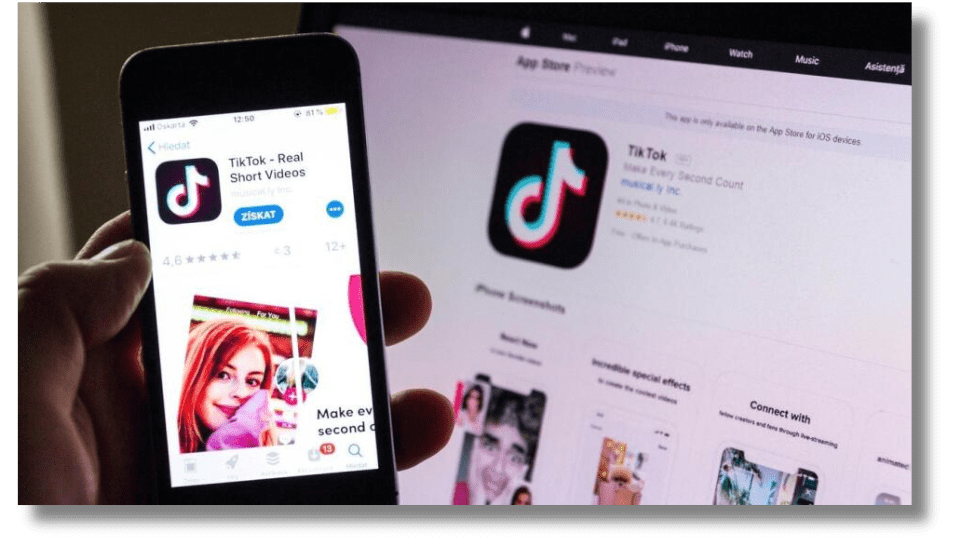
TikTok is a rapidly growing video-sharing platform that is viral among younger audiences. It offers unique opportunities for businesses to create engaging, entertaining content and reach new audiences through viral trends and challenges.
For TikTok, make sure that you create a winning video content strategy.
Selecting Platforms Based on Goals

When choosing social media platforms, consider how they align with your business objectives and target audience.
For example, if your goal is to drive website traffic, platforms that support link sharing, such as Facebook and Twitter, may be more effective. Visually-focused platforms like Instagram and Pinterest could be better suited if you aim to showcase your products.
Additionally, consider the demographics of each platform. If your target audience is primarily millennials, you should focus on Instagram and TikTok. If you’re targeting professionals, LinkedIn could be a better choice.
Focus on Quality Over Quantity
While being present on multiple social media platforms may be tempting, focusing on quality over quantity is essential. Spreading your resources too thin across many platforms can lead to inconsistent posting, poor engagement, and ineffective use of your time and budget.
Instead, focus on 2-3 platforms where your target audience is most active and where you can consistently create high-quality content. This approach allows you to build a strong presence, engage with your audience, and measure the effectiveness of your efforts.
Developing a Content Strategy
Creating engaging and relevant content is the foundation of a successful social media marketing strategy. To develop an effective content strategy, consider the types of content that resonate with your audience, plan your posts, and incorporate interactive elements to boost engagement.
Types of Content to Share
The types of content you can curate and share on social media can vary depending on the platform and your target audience.

Here are some common content types and their effectiveness on different platforms:
Images
High-quality visual content is effective on platforms like Instagram, Facebook, and Pinterest. They can showcase your products, highlight your brand’s personality, and drive engagement through likes and comments.
Videos
Video content is highly engaging and can be used across various platforms, including Instagram, Facebook, TikTok, and YouTube. Short-form videos like Instagram Reels and TikTok videos are particularly popular for their entertainment value and ability to go viral.
Stories
Ephemeral content like Instagram and Facebook Stories allows you to share behind-the-scenes glimpses, exclusive offers, and real-time updates with your audience. Stories are an effective way to build a personal connection with your followers.
Blog Posts
Sharing links to your blog posts on platforms like Twitter, LinkedIn, and Facebook can drive traffic to your website and position your brand as an industry thought leader. Long-form content allows you to dive deeper into topics and provide value to your audience.
Content Calendar Creation
Creating a content calendar is an essential tool for planning and scheduling your social media posts in advance. A content calendar helps you:
- Maintain Consistency: By planning and scheduling your posts ahead of time, you can ensure a consistent posting schedule that keeps your audience engaged.
- Ensure Variety: A content calendar allows you to mix up different types of content and topics, keeping your feed manageable and interesting.
- Collaborate Effectively: If you have a team working on your social media marketing, a content calendar facilitates collaboration and ensures everyone is on the same page.
- Analyze Performance: By tracking your posts in a calendar, you can analyze which types of content perform best and adjust your strategy accordingly.
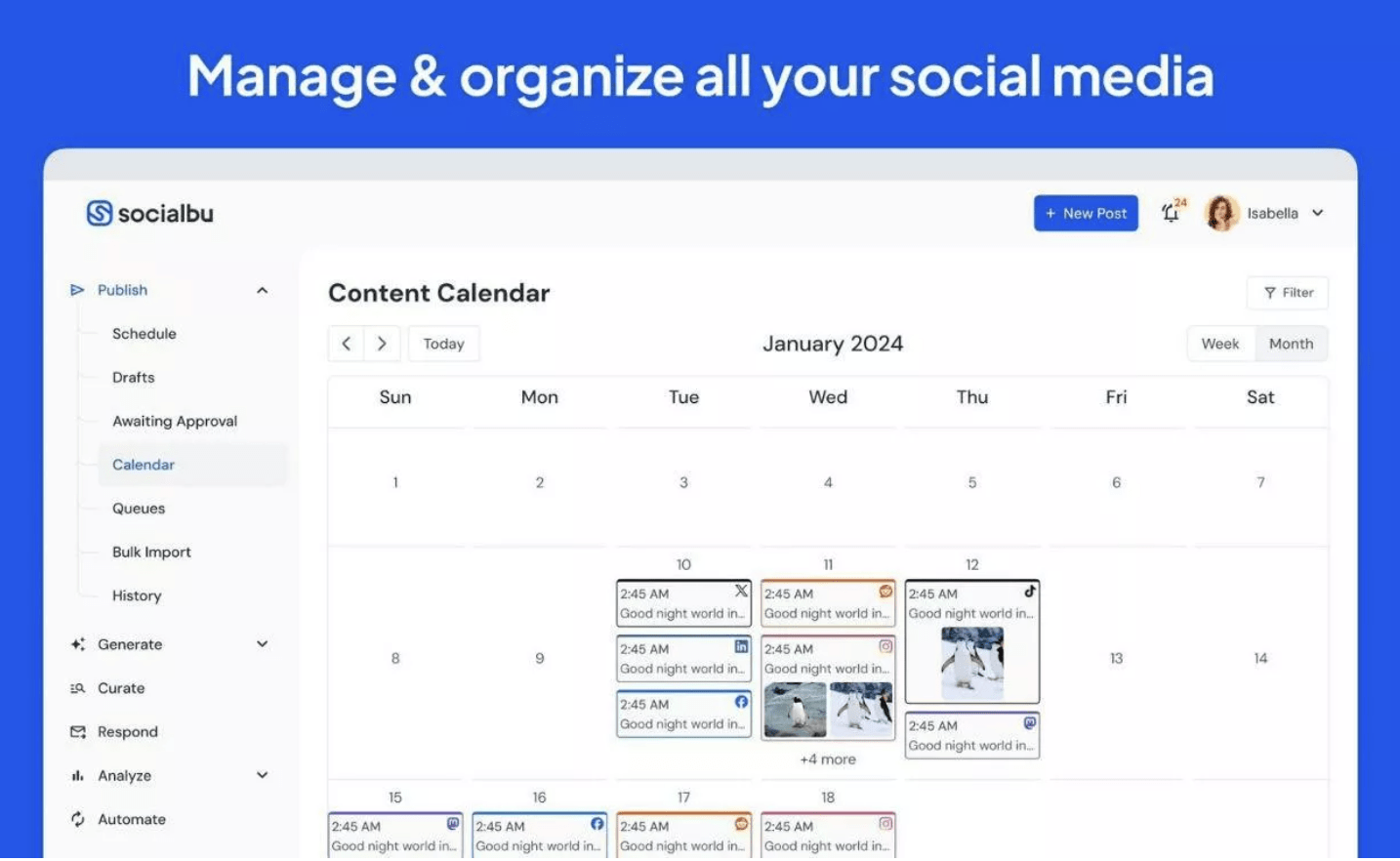
With SocialBu’s content calendar feature, you can plan, schedule, and visualize your social media strategy with ease. Furthermore, it lets you brainstorm ideas, assign tasks, and ensure a steady stream of engaging content across all your platforms.
Engaging Content Ideas
Incorporate interactive elements into your content strategy to keep your audience engaged through your social media presence. Here are some ideas to try:
Polls and Surveys
Ask your followers for their opinions on products, services, or industry-related topics. Polls encourage participation and provide valuable insights into your audience’s preferences.
User-Generated Content (UGC)
Encourage your followers to create and share content related to your brand using a branded hashtag or tagging your account. UGC helps build a sense of community and shows that you value your audience’s contributions. You can also collaborate with influencers and other creators to leverage UGC.
Behind-the-Scenes
Share glimpses of your company culture, product creation process, or team members to humanize your brand and build trust with your audience.
Contests and Giveaways
Run contests that incentivize followers to engage with your content, such as liking, commenting, or sharing posts. Giveaways are an effective way to attract new followers and increase brand awareness.
Responding to Comments and Messages
Audience interaction not only boosts your visibility but also strengthens brand loyalty. Furthermore, responding to comments and messages shows your audience that you value their opinions and feedback. This enhances customer satisfaction and encourages repeat business.
Here are some ideas to get better at responding to your audience:
- Be Prompt: Aim to respond to comments and messages as quickly as possible. A quick reply demonstrates that you are attentive and care about your audience’s inquiries or feedback.
- Personalize Your Responses: Use the follower’s name and tailor your responses to their comments or questions. Personalization makes your interactions feel more genuine and helps build rapport.
- Address Concerns: If a follower raises a concern or complaint, respond empathetically and offer solutions. Acknowledging issues and providing assistance can turn a negative experience into a positive one.
- Encourage Further Interaction: Ask follow-up questions or invite followers to share more about their experiences. This not only keeps the conversation going but also shows that you are interested in their opinions.
Conclusion
All in all, social media is not just about posting content; it’s about fostering relationships and creating meaningful interactions with your audience. Moreover, creating a winning social media marketing strategy is essential for any business looking to thrive in today’s digital landscape.
By setting clear goals, understanding your target audience, conducting competitive analysis, choosing the right platforms, you can ace your social media marketing strategy.
Moreover, maintaining a content calendar, engaging with your audience, and monitoring performance, will facilitate you in driving results from your social media presence.
Start today, and watch your social media efforts transform your business.
FAQS
What is social media marketing strategy meaning?
Social Media Marketing Strategy is a comprehensive plan that outlines how a business will use social media platforms to achieve its marketing goals. It involves understanding your target audience, setting specific objectives, creating engaging content, and analyzing your performance to measure success. Click here to understand social media marketing strategy in Hindi.
What are social media marketing strategies?
Social media marketing strategies are comprehensive plans that outline how a business will use social media platforms to achieve its marketing goals. These strategies define specific objectives, target audiences, content types, and metrics for success.
What are the 5 ways of social media marketing?
The five ways of social media marketing include content creation, social listening, engagement, advertising, and analytics.
What is the 50 30 20 rule for social media?
The 50 30 20 rule for social media content suggests that 50% of your posts should focus on engaging and entertaining your audience. Furthermore, 30% should provide informative or educational content, and 20% should promote your products or services.
What are the key steps in social media marketing strategic planning?
Key steps in social media marketing strategic planning include defining goals, identifying your target audience, competitor analysis, choosing platforms, and creating a content strategy. Monitoring performance and adjusting your strategy accordingly is also important.
What are the 5 pillars of social media marketing?
The five pillars of social media marketing are strategy, planning and publishing, engagement, analytics and reporting, and advertising.







